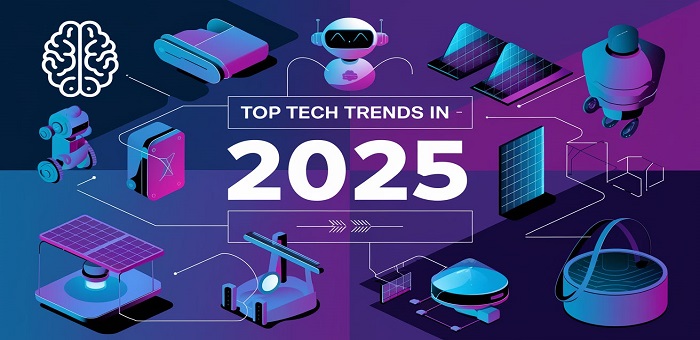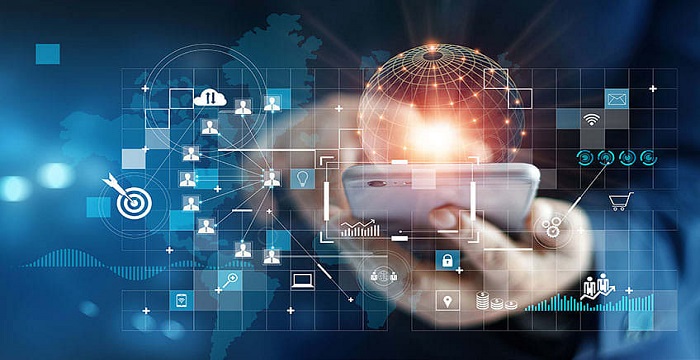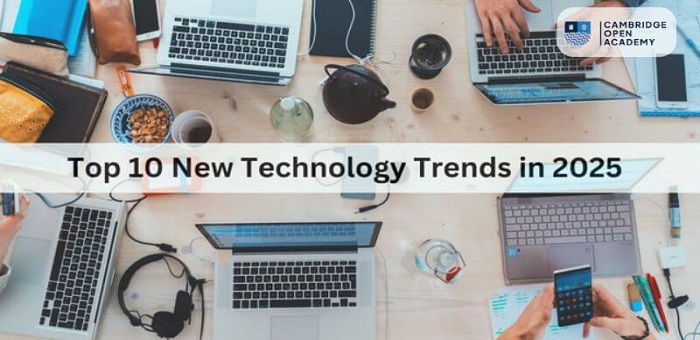The Top 10 Technology Trends Shaping 2025
The technological landscape of 2025 promises to be transformative, with innovations set to redefine industries and improve the quality of life. Here’s an in-depth look at the top trends expected to dominate:

1. Artificial Intelligence (AI): Beyond Automation
AI continues to evolve, transitioning from basic automation to advanced augmentation. Personal AI assistants will become sophisticated, offering seamless task management and decision-making optimization. Businesses will leverage AI to personalize customer experiences and make data-driven decisions.
Impact:
- Automates repetitive business processes.
- Optimizes decision-making.
- Drives breakthroughs in healthcare and personalized treatments.
2. Smart Cities: Sustainable Urban Living
Smart cities equipped with interconnected sensors and devices will enhance urban efficiency. From traffic management to waste reduction, these cities aim to improve sustainability and quality of life.
Impact:
- Real-time resource optimization.
- Reduced environmental footprint.
- Improved citizen experiences.
3. Extended Reality (XR): A New Dimension of Interaction
XR, encompassing Augmented Reality (AR) and Virtual Reality (VR), is set to enter mainstream use. Applications range from virtual shopping experiences to immersive training modules.
Impact:
- Enhances education and training.
- Redefines retail experiences.
- Facilitates informed customer decisions.
4. Internet of Things (IoT): Unprecedented Connectivity
The IoT ecosystem will expand significantly, with devices across industries connected via the internet. These devices will provide real-time data for enhanced decision-making.
Impact:
- Generates actionable insights for businesses.
- Develops adaptive and intelligent systems.
- Improves efficiency across sectors.
5. Cybersecurity: Countering Evolving Threats
As connectivity grows, cybersecurity becomes more critical. Companies and governments will prioritize AI-driven threat detection and robust security models to counter sophisticated cyberattacks.
Impact:
- Advanced AI-powered threat detection.
- Adoption of zero-trust security models.
- Increased vigilance in personal data protection.
6. Quantum Computing: Breaking Barriers
Quantum computing, leveraging qubits’ ability to exist in multiple states, will address complex problems at unparalleled speeds. Applications in materials science, drug discovery, and cryptography will emerge.
Impact:
- Accelerates breakthroughs in medicine and renewable energy.
- Revolutionizes machine learning applications.
- Enhances cryptography and secure communication.
7. Bioprinting: Revolutionizing Healthcare
3D bioprinting, utilizing living cells to create tissues and organs, is advancing rapidly. By 2025, the technology could offer solutions to organ shortages and accelerate drug discovery.
Impact:
- Enables personalized medicine.
- Aids regenerative therapies and disease modeling.
- Revolutionizes healthcare treatments.
8. Hyper-Automation: The Future of Workflows
Hyper-automation, combining AI, Machine Learning (ML), and Robotic Process Automation (RPA), will streamline business processes, enhancing efficiency and reducing costs.
Impact:
- Frees employees for strategic tasks.
- Raises productivity and cost-efficiency.
- Prompts workforce reskilling to mitigate job displacement.
9. Blockchain: Beyond Cryptocurrency
Blockchain technology will expand beyond financial applications to revolutionize supply chains, healthcare, and voting systems.
Impact:
- Enhances supply chain transparency.
- Secures voting systems and fosters trust in democracy.
- Improves record-keeping and data sharing in healthcare.
10. Future of Work: Flexibility and Innovation
Remote and hybrid work models, accelerated by the COVID-19 pandemic, will remain prevalent. Businesses will adopt advanced collaboration tools and focus on fostering creativity.
Impact:
- Promotes work-life balance.
- Requires continuous upskilling for employees.
- Strengthens virtual collaboration and company culture.
Beyond the Top 10: Emerging Technologies to Watch

Brain-Computer Interfaces (BCIs)
These interfaces promise direct interaction between the brain and computers, opening possibilities in prosthetics, augmented reality, and rehabilitation.
Digital Twins
Digital replicas of physical systems will enhance predictive maintenance, resource optimization, and product design.
Next-Generation Batteries
Advancements in solid-state and lithium-sulfur batteries will accelerate the adoption of electric vehicles and renewable energy.
Gene Editing
Technologies like CRISPR will revolutionize disease treatment, though ethical concerns will need careful consideration.
The Human Element in a Tech-Driven Future
- Critical Thinking: Evaluate technology’s impacts critically to ensure its responsible use.
- Human Connection: Prioritize real-world relationships alongside digital advancements.
- Ethical Considerations: Address privacy, data security, and automation-related challenges.
- Technology for Good: Leverage innovations to tackle global challenges like poverty, disease, and climate change.
FAQs
Q1. How can small businesses leverage these emerging technologies in 2025?
A. Small businesses can capitalize on emerging technologies to enhance efficiency, improve customer experience, and gain a competitive edge. Key strategies include:
- AI-Powered Tools: Use AI for personalized marketing, customer insights, and automating routine tasks like customer service with chatbots.
- IoT Devices: Implement smart devices for real-time inventory management and operational efficiency.
- Blockchain Platforms: Ensure secure and transparent transactions, especially for supply chains and digital contracts.
- Cloud Computing: Access scalable resources for data storage and software applications.
- 5G Networks: Benefit from high-speed connectivity for seamless operations.
Example: IoT-enabled inventory tracking helps minimize waste, while AI chatbots provide 24/7 customer support without the need for extra staff.
Q2. How will emerging technologies impact the job market in 2025?
A. Emerging technologies will reshape the job market, creating opportunities while automating repetitive tasks. Key impacts include:
- Automation: Up to 30% of tasks in many occupations may be automated, reducing demand for routine roles.
- Demand for Tech Specialists: High demand for data scientists, AI and ML specialists, cybersecurity professionals, and blockchain developers.
- Reskilling: Workers will need to acquire new skills to adapt to tech-driven roles.
- Industry Adaptations: Many organizations are investing in upskilling programs to help employees transition to new roles.
Fact: Studies show that industries like healthcare, finance, and logistics will increasingly rely on tech expertise, driving job creation in emerging fields.
Q3. What is the future of emerging technologies?
A. The future lies in the seamless integration of these technologies into daily life and industries. Highlights include:
- Automation & Connectivity: AI, IoT, and quantum computing will automate processes and enhance decision-making.
- Global Challenges: Innovations in biotechnology, renewable energy, and advanced computing will address issues like climate change, healthcare, and resource scarcity.
- Mainstream Adoption: Technologies like blockchain and extended reality will become everyday tools in business and personal use.
Emerging technologies will transition from experimental to essential, fostering smarter operations, global connectivity, and new business opportunities.
Q4. Which technology will be in demand in the next 5 years?
A. Technologies projected to dominate include:
- AI and Machine Learning: Powering automation, data analytics, and personalized applications.
- Cybersecurity: Essential for protecting digital infrastructure against sophisticated threats.
- Quantum Computing: Revolutionizing fields like cryptography, drug discovery, and financial modeling.
- Blockchain: Enhancing transparency and efficiency in finance, supply chains, and digital identity management.
- 5G/6G Networks: Enabling ultra-fast connectivity and unlocking new possibilities for IoT and XR applications.
Fact: With AI-driven tools and faster networks becoming essential, roles in these fields are expected to experience exponential growth.
